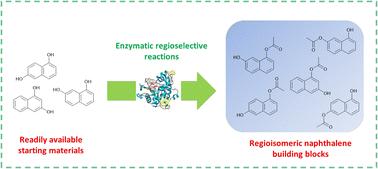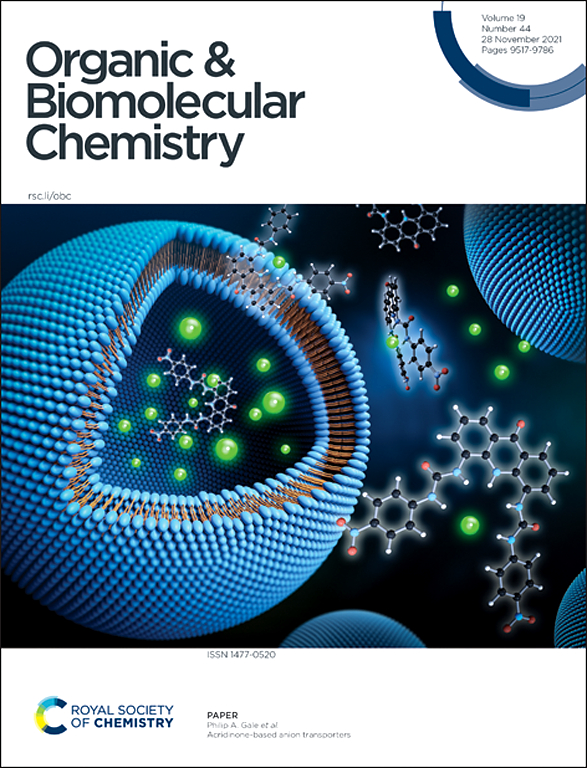Exploring lipase regioselectivity: synthesis of regioisomeric acetoxyhydroxynaphthalenes†
IF 2.7
3区 化学
Q1 CHEMISTRY, ORGANIC
引用次数: 0
Abstract
The naphthalene ring is a moiety featured by many bioactive agents. Dihydroxynaphthalenes are readily available substances but their use for the synthesis of a series of compounds results in limited chemical diversity due to the similar reactivity of the phenolic hydroxyl groups. Herein, we describe the use of regioselective lipases in acylation and hydrolysis reactions to synthesize 5 different regioisomeric acetoxyhydroxynaphthalenes on a 91–122 mg scale with moderate to good yields (50–78%) from 1,3-, 1,6- and 1,7-dihydroxynaphthalenes and their corresponding diacetates. Reactions were optimised through medium engineering, thus providing information on the impact of different organic solvents on conversion and selectivity. Additionally, computational studies using molecular dynamic simulations were performed and suggested a correlation between the regiopreference displayed by lipase CAL-B in hydrolytic reactions and a distance ≤3.2 Å between the most reactive carbonyl group and the Ser-105 residue on the catalytic site. The herein described enzymatic methods may allow for introducing two different moieties at the naphthalene ring through a protection–deprotection strategy, thus allowing for better exploitation of the chemical space.

探索脂肪酶的区域选择性:区域异构体乙酰氧基羟基萘的合成。
萘环是许多生物活性物质的特征基团。二羟基萘是一种很容易得到的物质,但由于酚羟基的反应活性相似,它们用于合成一系列化合物的结果是化学多样性有限。在此,我们描述了在酰化和水解反应中使用区域选择性脂肪酶在91-122 mg的范围内合成5种不同的区域异构体乙酰氧基羟基萘,从1,3-,1,6-和1,7-二羟基萘及其相应的二乙酸酯中获得中等到良好的产率(50-78%)。通过介质工程优化反应,从而提供了不同有机溶剂对转化率和选择性影响的信息。此外,利用分子动力学模拟进行的计算研究表明,脂肪酶CAL-B在水解反应中显示的区域优先性与催化位点上最活跃的羰基与Ser-105残基之间的距离≤3.2 Å之间存在相关性。本文所述的酶促方法可以允许通过保护-去保护策略在萘环上引入两个不同的基团,从而允许更好地利用化学空间。
本文章由计算机程序翻译,如有差异,请以英文原文为准。
求助全文
约1分钟内获得全文
求助全文
来源期刊

Organic & Biomolecular Chemistry
化学-有机化学
CiteScore
5.50
自引率
9.40%
发文量
1056
审稿时长
1.3 months
期刊介绍:
Organic & Biomolecular Chemistry is an international journal using integrated research in chemistry-organic chemistry. Founded in 2003 by the Royal Society of Chemistry, the journal is published in Semimonthly issues and has been indexed by SCIE, a leading international database. The journal focuses on the key research and cutting-edge progress in the field of chemistry-organic chemistry, publishes and reports the research results in this field in a timely manner, and is committed to becoming a window and platform for rapid academic exchanges among peers in this field. The journal's impact factor in 2023 is 2.9, and its CiteScore is 5.5.
 求助内容:
求助内容: 应助结果提醒方式:
应助结果提醒方式:


